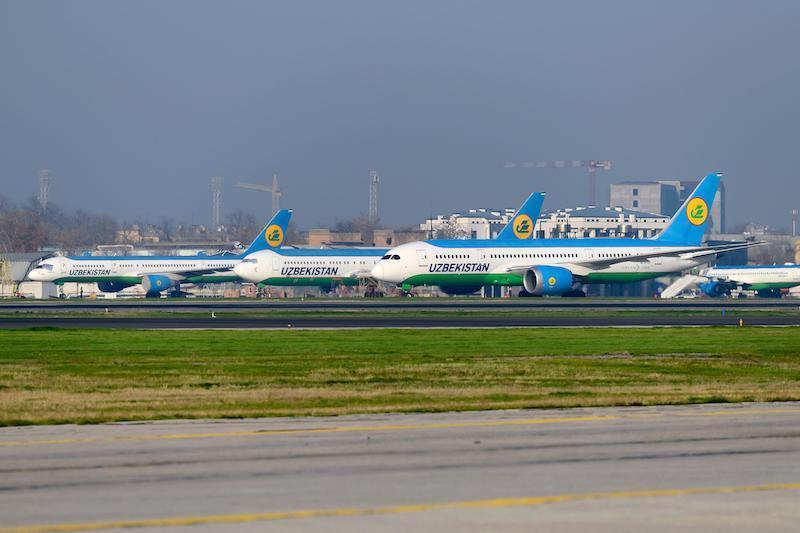
TASHKENT, Uzbekistan—Growing commercial fleets in Uzbekistan and neighboring countries in post-Soviet Central Asia are increasing demand for MRO services.
Existing aftermarket service providers are expanding their capacity and capabilities to meet the market, while new suppliers and investors move into the region.
The region’s commercial fleet now amounts to almost 180 airliners. Almost half of them—85 airframes—are operated in Kazakhstan. Uzbekistan currently has 53 commercial airliners and is quickly expanding. Turkmenistan still has a single government-owned airline, while the fleets in Kyrgyzstan and Tajikistan are tiny.
According to Lufthansa Consulting estimates, the region has a noteworthy base maintenance capability gap when compared to international benchmarks. Kazakhstan and Uzbekistan are the only countries in the region with local MRO providers: Air Astana and Uzbekistan Airways Technics (UAT). Both are busy expanding in response to growing demand from their parent airlines and other local customers.
Air Astana’s MRO division has been developing its base maintenance expertise at Almaty and Astana airports. The airline had an alternative option, when it agreed to a five-year contract with Russia’s S7 Technics for Airbus A320 and Boeing 767 work in 2019. But Russian providers have been excluded from the global MRO industry since 2022 after the introduction of Western sanctions.
Air Astana can perform all C checks on A320ceo-family aircraft and plans to reach the same level of expertise on the 767. Its first C1 check on the 767 was performed in Almaty in 2019. Twenty-five heavy checks from C1 to C6 have been carried out since then.
The company now plans to make a first C12 check on a 767 in Astana in September, says Robert Dando, Air Astana’s senior manager of maintenance, who was speaking at the MRO Central Asia conference in Tashkent held March 26-27.
The next step will be to master the same expertise on the 787, which is scheduled to join Air Astana’s fleet in 2025. The carrier plans to construct two new hangars in Almaty and another in Astana to accommodate the type. However, these will not necessarily be ready in time for the first delivery, Dando tells Aviation Week.
While the MRO division is focused on the needs of its parent carrier and LCC subsidiary FlyArystan, the feasibility of performing work for third parties is being assessed, Dando says.
By contrast, across the border, Uzbekistan’s leading MRO provider UAT—which has a monopoly on heavy maintenance in the country—is very open about doing work for other domestic airlines and carriers from across the region, offering services for a wide range of Airbus and Boeing types.
UAT wants to add two new hangars in Tashkent this year which will be capable of accommodating aircraft as large as the 747, CEO Umid Khusanov says. UAT also plans to master base maintenance for two new types: the A330 and 737 MAX. The number of A330s in Uzbekistan is growing. Uzbekistan Airways wet-leased a pair of them from Heston Airlines in 2023. A330s are also operated by the private Uzbek carriers Air Samarkand, Panorama Airways, and Qanot Sharq.
In the background, UAT is working to secure U.S. FAA certification this year to add to the approvals it has received from 15 other aviation authorities. FAA approval is required by some of UAT’s potential customers, so the company decided to obtain it, Khusanov says.
He promises that UAT will introduce Swiss-made AMOS MRO software in 2024 to speed up the maintenance process. The company is aiming to increase its work by 20% this year.
Other Uzbek carriers have the choice of sending their aircraft for heavy maintenance in Turkey, Gulf states, or Europe, but these repairs require additional approvals from Uzbekistan’s aviation authority.
Rather than going abroad, emerging carriers are thinking about developing in-house maintenance capabilities. The country’s first private airline, Qanot Sharq, has already started performing its own line maintenance.
Another Uzbek newcomer, My Freighter (MF) group, will open its first line maintenance station in May, says Gennady Kharlap, the company’s technical advisor. The group operates cargo specialist MF Airlines and passenger airline Centrum Air.
MF currently contracts UAT to perform line and basic maintenance for its fleet of eight aircraft. It will start in-house line maintenance on A320s operated by Centrum Air. The second type will be 767Fs, which constitute the core of MF Airlines’ fleet.
Smaller carriers still prefer to outsource MRO services. “All line and heavy maintenance will be outsourced, as UAT will be the starting point,” says Rene Gsponer, COO of Uzbekistan’s only LCC Humo Air, which is looking for new aircraft to resume operations in the coming months.
Cargo operator Fly Khiva, another Uzbek newcomer, leased its first 767F on the condition that maintenance would be provided by the lessor, the airline’s Vice President Alisher Nurmatov says. Fly Khiva is expected to launch services in April and plans to add two more 767Fs in 2024.
“Fly Khiva has plans for [in-house] line maintenance, but it is unlikely to be located in Tashkent,” Nurmatov says. The location could be Navoi International Airport, some 230 mi. west of Tashkent, which has been developing as a cargo hub since 2009. The government is now making efforts to turn it into an MRO center, too.
On March 26, Navoi’s owner Uzbekistan Airports signed a preliminary agreement with Italian MRO provider EU Wings to create a joint base maintenance center there at the airport. The partners plan to build a hangar at Navoi to service A320s and 737s. The joint venture is expected to be operational within the next 18 months, an EU Wings representative tells Aviation Week.
The Italian company already provides line maintenance for logistics operator Maersk in Navoi. EU Wings also has line stations in Tashkent and Samarkand.
Ukraine-based BEST MRO Group tells Aviation Week that it is also in discussions with local partners about launching a base maintenance station in Navoi.





